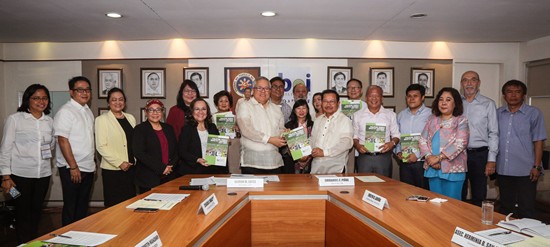|

DTI
Secretary Ramon M. Lopez and DA Secretary Emmanuel F. Piñol
sign the Philippine Rubber Industry Roadmap 2017-2022. |
DTI, DA lead
efforts to strengthen PH rubber industry
By
DTI- OSEC-PRU
April 17, 2018
MAKATI – The
Department of Trade and Industry (DTI) and the Department of
Agriculture (DA) led the inter-agency signing of the Joint Statement
of Commitment for the “Philippine Rubber Industry Roadmap 2017-2022”
on 16 April 2018.
“The cluster approach
[that addresses the gaps and opportunities in the entire value chain
from the rubber production to processing and manufacturing of
finished products] is the way to go,” said DTI Secretary Ramon M.
Lopez. “This industry is critical in helping achieve President
Duterte’s vision of real inclusive growth since the rubber
production sector involves over 55,000 small farmers/growers.”
Ninety percent of the
rubber farmers in the country are small growers, most are from the
Mindanao region – Zamboanga Peninsula, SOCCSKSARGEN, and ARMM.
“DTI is committed to
expand market and processing opportunities for their products by
bringing in more investors on rubber processing and rubber-based
products, like tire companies, and linking them with the local
rubber suppliers,” the trade chief added. He also said Philippine
(PH) rubber can be used for rubberized asphalt for road projects in
the government’s “Build Build Build” program.
Meanwhile, DA Secretary
Emmanuel F. Piñol said that rubber has a crucial role in the
reformatting of the PH agriculture plan.
“The agricultural areas
I’ve visited suffer from the same problems: soil erosion and
landslides. These are indications of poor agricultural planning –
where farmers are planting crops where we should be planting rubber
trees,” Sec. Piñol said.
The roadmap outlines steps
in the following aspects of rubber production: (1) Production &
Productivity Improvement; (2) Processing and Manufacturing; (3)
Domestic and Export Marketing, (4) Research, Development and
Extension; (5) Finance and Investment Promotion; and (5)
Information, Policy Formulation and Advocacy.
Aside from the DTI and DA,
the inter-agency cluster consists of the departments of Science and
Technology (DOST), Environment and Natural Resources (DENR), and
Agrarian Reform (DAR), as well as the Technical Education and Skills
Development Authority (TESDA), the Mindanao Development Authority (MinDA),
the Philippine Rubber Industries Association (PRIA), the Philippine
Rubber Farmers Association (PRFA), and the University of Southern
Mindanao (USM).
PH is currently a minor
producer of rubber, yielding 1% of the natural rubber in the world
as compared to top producers Indonesia and Thailand that produce 25%
and 34% of global production, respectively. Despite this, the PH
rubber industry is steadily growing – for the last quarter of 2017,
rubber production grew by 8.9% to 138.24 thousand MT from 126.94
thousand MT in the same quarter of 2016.